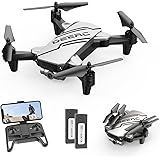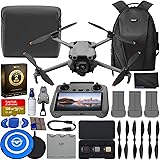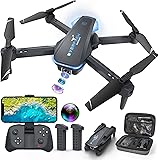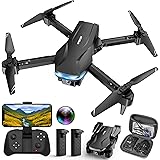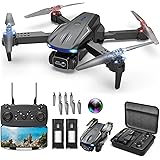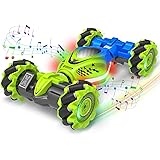The excitement of unboxing a new gadget, especially something as captivating as a drone, is truly palpable. If you just watched the unboxing video above, you likely felt the anticipation as the plastic packaging rustled open, the controller was handled, and the drone propellers began to whir. This initial interaction is often the gateway for aspiring pilots, but selecting the right beginner drones can feel daunting with so many options available.
Many new enthusiasts face a common dilemma: how do they choose a drone that offers both an engaging flight experience and a gentle learning curve? Our goal here is to demystify the process, guiding you through the essential considerations for your first quadcopter. We’ll ensure your journey into the skies is both rewarding and safe, helping you navigate the world of beginner drones with expert advice.
What Makes a Drone Truly Beginner-Friendly?
When you’re stepping into the exhilarating world of drone piloting, the sheer variety of models can be overwhelming. A truly beginner-friendly drone isn’t just affordable; it possesses a suite of features designed to forgive mistakes and build confidence. Understanding these core attributes is crucial for making an informed decision about your first aerial companion.
-
Intuitive Flight Systems and Stability
First, consider the ease of control. Beginner drones typically feature advanced stabilization technologies, often incorporating GPS and optical flow sensors. These systems allow the drone to hold its position accurately, even in light winds, which is a game-changer for new pilots. Imagine trying to learn to drive a car that constantly drifts – it’s frustrating and prone to accidents. A stable drone minimizes this initial challenge, letting you focus on directional control rather than constant corrections.
-
Durability and Design
Secondly, evaluate durability. Let’s be realistic: your first drone will likely encounter a few unexpected landings. Manufacturers design beginner models with more robust frames, often from flexible plastics, and propeller guards that absorb impact. This resilience means less time spent on repairs and more time in the air, allowing you to learn without constant fear of damaging your investment.
-
GPS, Return-to-Home, and Geofencing
Thirdly, essential safety features are paramount. Features like automatic Return-to-Home (RTH) are invaluable, ensuring your drone can find its way back to you with the press of a button or when the battery runs low. Geofencing, another critical safety net, prevents the drone from flying into restricted airspace, providing an invisible barrier for novice pilots. These technologies protect your drone and respect airspace regulations, offering peace of mind during your initial flights.
Beyond the Unboxing: Features to Prioritize in Your First Beginner Drone
After the initial thrill of unboxing, as seen in the video, comes the practical consideration of what your drone can actually do. While the unboxing highlights the physical product, it’s the underlying capabilities that define the user experience. Focusing on key performance features will ensure your beginner drone meets your aspirations for aerial exploration.
-
Capturing Aerial Views Without Compromise
Fourth, think about camera quality versus the learning curve. Many beginner drones now come equipped with impressive cameras capable of recording crisp 1080p or even 4K video. While high resolution is appealing, prioritize a stable camera gimbal that effectively counters vibrations and movement. A stable, clear image from a 1080p camera often looks better than shaky 4K footage. You want to capture smooth, shareable aerial photography and videography right from your first flight.
-
Maximizing Your Airtime Experience
Fifth, consider battery life and flight time. Entry-level drones typically offer flight times ranging from 10 to 20 minutes per battery charge. While this might seem short, remember that longer flight times usually mean larger, heavier batteries, impacting the drone’s agility and cost. Many pilots opt for purchasing extra batteries to extend their flying sessions, allowing for more practice and exploration before needing to recharge.
-
Ergonomics and User Experience
Sixth, the importance of a good controller cannot be overstated. As the video’s sound events suggest, handling the game-like controller is a significant part of the experience. Look for a controller that feels comfortable in your hands, with responsive joysticks and clearly labeled buttons. Some controllers even feature a smartphone mount for FPV (First Person View) flying, turning your phone into an indispensable flight display. A well-designed controller makes precision maneuvers more intuitive and enjoyable for beginner drone pilots.
Navigating the Skies: First Flights and Regulatory Insights
Once you’ve unboxed your new drone and charged its batteries, the urge to get it into the air is undeniable. However, successful and safe piloting, particularly for beginner drones, involves more than just launching it. Understanding basic flight mechanics and, crucially, the regulatory landscape is vital for a responsible and enjoyable experience.
-
Mastering Basic Maneuvers
Seventh, practice truly makes perfect. Start in an open, unpopulated area, away from obstacles and other people. Begin with simple take-offs and landings, gradually progressing to hovering, forward, backward, and sideways movements. Many beginner drones offer ‘headless mode,’ which simplifies orientation, and ‘altitude hold,’ which maintains height automatically. Utilize these features to build your confidence before tackling more complex aerial maneuvers.
-
Staying Compliant and Safe
Eighth, understanding drone regulations is non-negotiable. Depending on your region, you might need to register your drone with aviation authorities, pass a knowledge test, or adhere to specific airspace restrictions. Imagine inadvertently flying into restricted airspace; the consequences can range from fines to legal action. Always check local laws and use apps like B4UFLY in the US to confirm safe and legal flying zones. Compliance ensures the safety of everyone, both in the air and on the ground.
Investing Wisely in Your Drone Journey
Your first drone purchase isn’t just about buying a gadget; it’s an investment in a new hobby, a potential skill, and countless hours of aerial adventure. Choosing from the array of beginner drones available requires careful consideration of both immediate costs and your long-term aspirations as a pilot.
-
Finding Value in Beginner Drone Models
Ninth, consider your budget for your first quadcopter. While it’s tempting to jump straight to the most feature-rich models, beginner drones offer incredible value without breaking the bank. You can find excellent options with stable flight, decent cameras, and robust safety features in the $150-$400 range. Focus on models that offer a balance of these elements, rather than just the cheapest or the most expensive, ensuring you get the most out of your entry-level experience.
-
Upgrading Your Skills and Gear
Tenth, think about your growth path. A beginner drone should ideally be something you can learn on and then potentially graduate from, rather than something you quickly outgrow and abandon. As your skills develop, you might seek out drones with more advanced camera capabilities, longer flight ranges, or even FPV racing potential. Your initial choice in beginner drones sets the foundation for a lifelong passion, making it a truly strategic first step.




